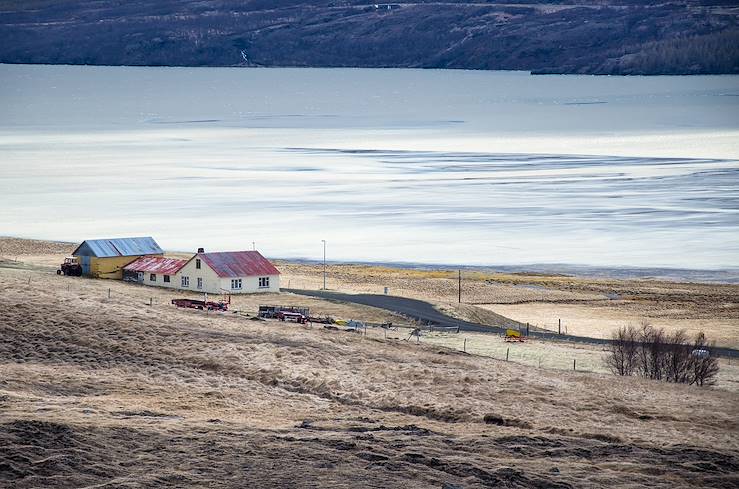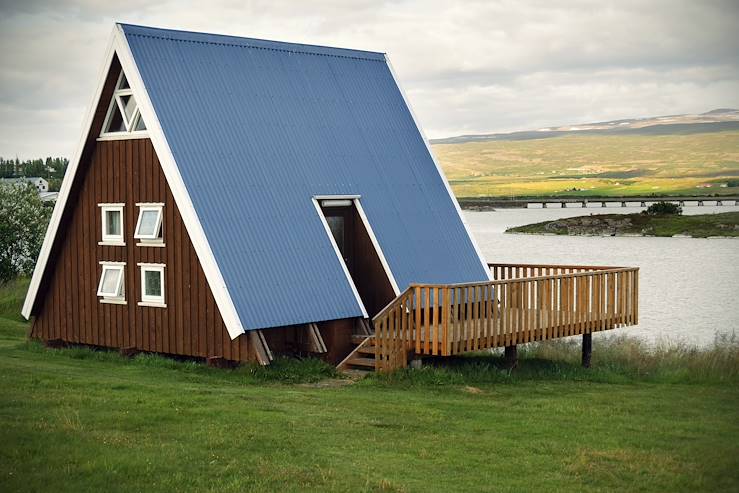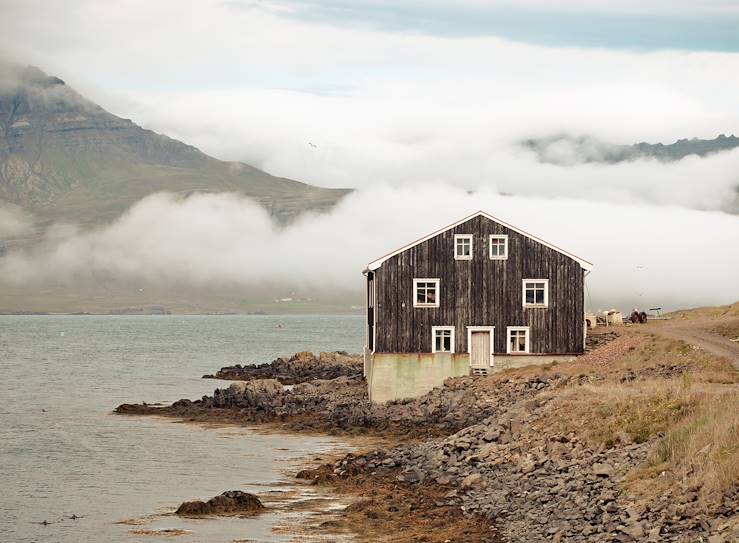- A road trip around Iceland, heading to the secret region of the East Fjords: an enormous expanse that feels like it's at the end of the world
- You'll stay in high-quality hotels, visit the amazing landmarks of Iceland, and take domestic flights to give you flexibility
- The itinerary includes a boat trip and bathing in the hot springs of Lake Myvatn
- Personalise your trip with a visit to the Harpa Centre in Reykjavik, and flight over the Askja caldera.
Contact one of our Iceland specialists + 44 (0) 20 3958 6120






Another journey through Iceland

Hit the road
Your hire car allows you to travel in freedom and at your own pace; the roads are safe and traffic is minimal. You'll travel very short distances - between 18 and 95 miles a day - so you can get the most out of the stunning beauty of the coastal roads and sights you visit. You'll also take two domestic flights to save time and give you flexibility. You'll stay in a converted fishing vessel, a farm at the end of the world and a former embassy; each are full of charm and character. Your itinerary includes a private boat trip on the Eyjafjordur fjord and bathing in the hot springs of Lake Myvatn. And for any advice or last-minute requests, our local Concierge is just a telephone call away.Route
Flight to Akureyri via Reykjavik - Siglufjordur
Welcome on arrival at Iceland International Airport and transfer to the Icelandic capital. There's no time to pause in Reykjavik. No sooner have you arrived, you'll leave on a 45-minute domestic flight to Akureyri, the capital of the north, to explore the Arctic Circle. On arrival, pick up your hire car and head off to the northern tip of the coastal region of Eyjafjordur. You'll be staying for two nights in an old converted fishing vessel on the Siglufjördur marina - its rooms have lovely parquet floors and panelled ceilings, providing beautiful views of the harbour and surrounding mountains. The restaurant offers a twist on Icelandic cuisine and serves fish just brought in by local fishermen . You'll love - Reading the Dark Iceland series by Ragnar Jonasson, crime novels and real page turners , whose breathtaking narrative takes place here in Siglufjördur.
Siglufjordur
In the itinerary - a boat trip on the Eyjafjordur fjord, whose waters are sometimes visited by common mink whales, sei whales, fin whales, humpback whales, and blue whales. Things to see and do - Visit the Glaumbaer Museum, a traditional farmhouse with peat walls and a grass-covered roof, built between the 18th and 19th centuries and converted into a museum - walk around the Skagi Peninsula, far away from the crowds, exploring its wild atmosphere - visit the beautiful Ketubjorg cliffs, on the east coast of the peninsula, from which a gorgeous waterfall flows directly into the sea - bathe in the springs in the village of Grettislaug, admiring Skagafjordur Fiord - from the small harbour here, boats depart for Drangey Island, whose high cliffs are home to flocks of guillemots and puffins.
Siglufjordur - Myvatn
Next stop, the Myvatn region. Head for the Jokulsa Canyon where Dettifoss Falls roar through a mineral landscape. Further afield is the river's delta , where thousands of inlets flow into the Arctic Ocean. The trail ends at Asbyrgi, a large horseshoe-shaped cliff. The road then follows the coast and passes through the colourful village of Husavik, the gateway to Lake Myvatn. The diverse scenery hints at the fact that this area was the scene of multiple volcanic eruptions. The blue-tinted waters of the Viti crater contrast with the surrounding anthracite lava flows. Pseudo-craters, ruin-like formations, explosion craters, boiling mud pots and lava flows make up an ecosystem that is entirely unique in this part of the world. The lake is also an exceptional haven for ducks - fifteen species nest in the shallow waters, including the Barrow's goldeneye, a white-spotted black head, the harlequin goldeneye with its black plumage streaked with white lines, and the red-eyed slave grebe. You'll spend two nights at your hotel, a large single-storey building with tall floor-to-ceiling windows that open out onto the surrounding nature. You'll love the comfortable rooms with their wooden walls and dimmed lighting.
Myvatn
You itinerary includes tickets to the Myvatn Blue Lagoon. This blue lagoon in the north is less touristy than the Reykjanes Peninsula. The huge body of turquoise blue water, which is close to 40°C, offers stunning views of the surrounding volcanoes and lava flows - ideal for outdoor bathing. Things to see and do - Hverir, an area covered with fumaroles and mud pools formed from an eruption - the pseudo-crater of Skutustadir - the ruins-like formations of Dimmuborgir - the field of solfataras and boiling mudpots of Namaskard - the Leirhnjukshraun lava field - Lake Viti. You'll love - Reaching the top of the Hverfjall stratovolcano for a splendid view of the duck filled lake and its surrounding mountains. Option - Flight over Myvatn Lake.
Myvatn - Seydisfjordur
Now head east to Egilsstadi, which, with its two thousand inhabitants, is the largest of the towns in the east of Iceland. From there, you'll go Seydisfjordur, the eastern tip of Iceland, where you'll have breathtaking views all along the coastal route. Seydisfjordur is undoubtedly one of Iceland's most beautiful villages, protected by the foothills of a fjord carved by time. The village centre, an important fishing harbour in the 19th century, is very colourful with its Norwegian-style wooden houses. Seydisfjordur has a thriving arts scene, particularly during summer, with artists coming from all over the country and from abroad. Spend two nights in your hotel. The property has two wings, the first in a traditional house that retains its old charm, with old-fashioned parquet flooring and 1920s furnishings, and the second in the old post office, which provides more modern, but equally comfortable, rooms. The restaurant is one of the most renowned in the country. It's the perfect place to immerse yourself in Icelandic culture. Things to see - Hengifoss Falls one of the tallest waterfalls in the country; Mjoifjordur fjord, one of the most beautiful in the region : to get there, you'll drive up an unpaved road with a few rather tight bends. The tiny fishing port of Brekka and the small church there are the only traces of human presence in this impressive landscape, especially at dusk.
Seydisfjordur - Breiddalur Valley
You'll then continue south to the cliff of Raudubjorg, which are known as the 'red cliffs', caused by the presence of rhyolite, and which are famous for the light they give off, as if they continually reflect the sun. At sunset you'll love watching the cliffs as they turn red; it's magical A little further south is Gerpir, Iceland's most eastern tip , where the surrounding cliffs soar more than 2,112ft above the ocean. At the edge of the fjord, you'll reach - via a 1,950ft long tunnel under the rock - the easternmost village of Iceland, Neskaupstadur - en route it feels as though you've been swallowed by the mountain Before the tunnel was built, the village was cut off from the rest of the island all winter, when the road that crosses the pass was impassable. Then you'll head to Djupivogur, a small hamlet nestled between steep mountains and the sea, with a long history of maritime trade. The village's oldest house, a red wooden house built in 1790, has been converted into a coffee shop and cultural centre. Here you can tuck into a big slice of homemade carrot cake, admiring the works of sculptor Rikardur Jonsson. Just a short distance away, you can hike in the Bulandsnes nature reserve, a birdwatcher's paradise. Stay for two nights on a farm in the Breiddalur Valley - from the outside, it looks nothing more than a simple farm. Yet this guesthouse, run by a couple of former city dwellers, offers beautiful modern interiors. On-site, there's a sauna and hot tub to relax, a lounge to socialise in, and a restaurant that showcases local produce. All around you there are endless possibilities for hiking or cycling. Things to see - The former French hospital, which was converted into a museum, in Faskrudsfjordur. From 1850 to 1914, during the cod fishing season (March to September) French vessels and crews came mainly from Dunkirk - some Dunkirk shipowners sent up to ten vessels a year - and from Calais, Gravelines, Fécamp, or Saint-Malo. Cod fishing in Iceland was conducted in extreme weather conditions, where there were frequent storms and no lighting - life on board was harsh, and many never returned from Iceland. The museum pays tribute to them.
Breiddalur Valley - Egilsstadir - Reykjavik
Head to Egilsstadir. Return hire car and fly to Reykjavik. Transfer to your hotel in the centre of Reykjavik, which charms with its intimate atmosphere, comfortable interiors and great service. On site, there's a restaurant and bar, a gym and a small wellness centre. Things to see and do - Walk through district 101 to Laugavegur Street, a 'village' where you can meander through brightly coloured houses, cafes, galleries, showrooms, design shops and concept stores, and where you may be tempted by a wool blanket or the creations of up-and-coming designers - climb to the top of Hallgrimskirkja Church - visit Marshall House, a former herring factory opened in 1948 and financed by the Marshall Plan, which has been converted into an exhibition space for artists collectives. Option - Visit the Harpa Centre.
Return flight
A la carte
FLIGHT OVER MYVATN
The lake seen from the sky, the landscapes of this land of fire and ice and its geothermal phenomena are strikingly beautiful. After exploring the surroundings of Lake Myvatn you'll fly south over Odadahraun, Iceland's largest desert, towards Askja, a stratovolcano in the highlands that reaches 4,900ft. On the way back, you'll fly over Mount Herdubreid, often called 'The Queen of Icelandic Mountains', with Hverfjall, Namafjall, and Krafla on the horizon, before landing in Reykjahlid. A 75-minute flight in a five-passenger Cessna.
Optional
PRIVATE TOUR OF THE HARPA CENTRE, REYKJAVIK
Facing the sea and Mount Esja, the glass and steel parallelograms of the Harpa Centre rise up between land and sea. Opened in May 2011, the Harpa is a venue for opera, concerts and conferences, symbolising the revival of the harbour district. The huge building is located in an area in full transformation mode. Inspired by Icelandic landscapes and the northern lights, its spectacular facades made up of ten thousand pieces of stained glass reflect the lights of the sky and the waves of the sea. Its beauty lies in the interaction between the large amount of concrete and the dynamic facade, which represent the island's rock formations and basalt columns. The building was designed by Henning Larsen and Olafur Eliasson, all in a setting of light and transparency.
Optional
A Rough Idea of Price
Our local concierges
Travel diary app
UK airport lounge
Perfect picks
Modify your itinerary
UK departure assistance
CO2 absorption



